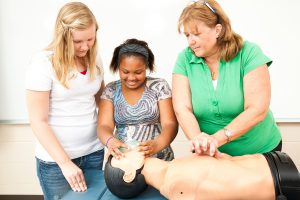Should Your Kids Learn CPR for Safe Backyard Play?
Mar 15th 2017

CPR basics for children are important and can be potentially life saving.
I am one of those people that schedules out the meals for the week on Sundays, writes down any appointments on the family calendar, and likes to plan out the day mentally in my mind when I wake up; I guess you could say I like to be prepared. But emergencies are not always something we are prepared for. Would you be able to do CPR if you had to? Would your child be able to?
CPR, or cardiopulmonary resuscitation, is one first aid protocol that everyone should be acquainted with. This technique for reviving someone who has lost consciousness or the ability to breath is done through chest compressions and mouth-to-mouth breaths. The process is something you never want to think about doing – especially as a parent – but it’s a technique that you should be familiar with. But, do your children need to know it? The practice is being taught more often in schools, and for good reason. There’s no harm in preparing your child for any situation they may face, especially when it comes to saving a life.
Teaching CPR in schools
Beginning in 2016, new laws were passed in several states across the county requiring schools to train students in CPR before high school graduation. The knowledge and training related to first aid and CPR can be a valuable experience for children of all ages in understanding how they can prepare for emergency situations. By teaching CPR in schools, local governments are hoping that cardiac survival rates within communities will get a much-needed boost.
The appropriate age to train your children
While there’s no specific age limit for training your child on CPR, you’re not going to train your toddler! For a frame of reference, I would recommend asking yourself if your child is capable and physically able to give compressions on an adult chest effectively. If your child is capable enough to dial 911, he or she is likely ready to begin the necessary training and understanding of the situation.
When CPR can come in handy
It’s a scary realization that only about 46 percent of people who experience an out-of-hospital cardiac arrest get the immediate help that they need before professional help arrives. While a mother wants to think they, or a responsible adult, is always around their child; it is more likely that your child is always around another child. It stands to reason that children know the proper protocol to take in a time of need.
Additionally, children between the ages of 10 to 12 typically begin taking jobs as babysitters. Teaching babysitters about child and infant CPR will help give them the tools they need to be confident with their new responsibilities. Although children are nowhere near as strong as adults in performing CPR in an effective manner, it’s important to keep them informed of the process if there is ever a time for them to utilize these skills.
What you should know about teaching your children
Only you as a parent can know what your child is capable of understanding. If you think they might be ready, your first steps can be teaching them the basics of CPR, along with the functioning of respiratory systems. This will better help them understand the benefit and purpose of CPR.
Of course, children don’t have the same attention span as adults so you might not want to fill them with too much information at once. Try working on it for at least 10 minutes and then refreshing it with them the next day to see if they understood. You can even try to make a game out of it!
And speaking of safety, there’s nothing safer (and more fun) than a JumpSport trampoline. Discover how your children can have fun, with safety that will last a lifetime!

